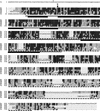C. elegans mre-11 is required for meiotic recombination and DNA repair but is dispensable for the meiotic G(2) DNA damage checkpoint
- PMID: 11238374
- PMCID: PMC312651
- DOI: 10.1101/gad.864101
C. elegans mre-11 is required for meiotic recombination and DNA repair but is dispensable for the meiotic G(2) DNA damage checkpoint
Abstract
We investigated the roles of Caenorhabditis elegans MRE-11 in multiple cellular processes required to maintain genome integrity. Although yeast Mre11 is known to promote genome stability through several diverse pathways, inviability of vertebrate cells that lack Mre11 has hindered elucidation of the in vivo roles of this conserved protein in metazoan biology. Worms homozygous for an mre-11 null mutation are viable, allowing us to demonstrate in vivo requirements for MRE-11 in meiotic recombination and DNA repair. In mre-11 mutants, meiotic crossovers are not detected, and oocyte chromosomes lack chiasmata but appear otherwise intact. gamma-irradiation of mre-11 mutant germ cells during meiotic prophase eliminates progeny survivorship and induces chromosome fragmentation and other cytologically visible abnormalities, indicating a defect in repair of radiation-induced chromosome damage. Whereas mre-11 mutant germ cells are repair-deficient, they retain function of the meiotic G(2) DNA damage checkpoint that triggers germ cell apoptosis in response to ionizing radiation. Although mre-11/mre-11 animals derived from heterozygous parents are viable and produce many embryos, there is a marked drop both in the number and survivorship of embryos produced by succeeding generations. This progressive loss of fecundity and viability indicates that MRE-11 performs a function essential for maintaining reproductive capacity in the species.
Figures




References
-
- Ahmed S, Hodgkin J. MRT-2 checkpoint protein is required for germline immortality and telomere replication in C. elegans. Nature. 2000;403:159–164. - PubMed
-
- Alani E, Padmore R, Kleckner N. Analysis of wild-type and rad50 mutants of yeast suggests an intimate relationship between meiotic chromosome synapsis and recombination. Cell. 1990;61:419–436. - PubMed
Publication types
MeSH terms
Substances
Grants and funding
LinkOut - more resources
Full Text Sources
Molecular Biology Databases
